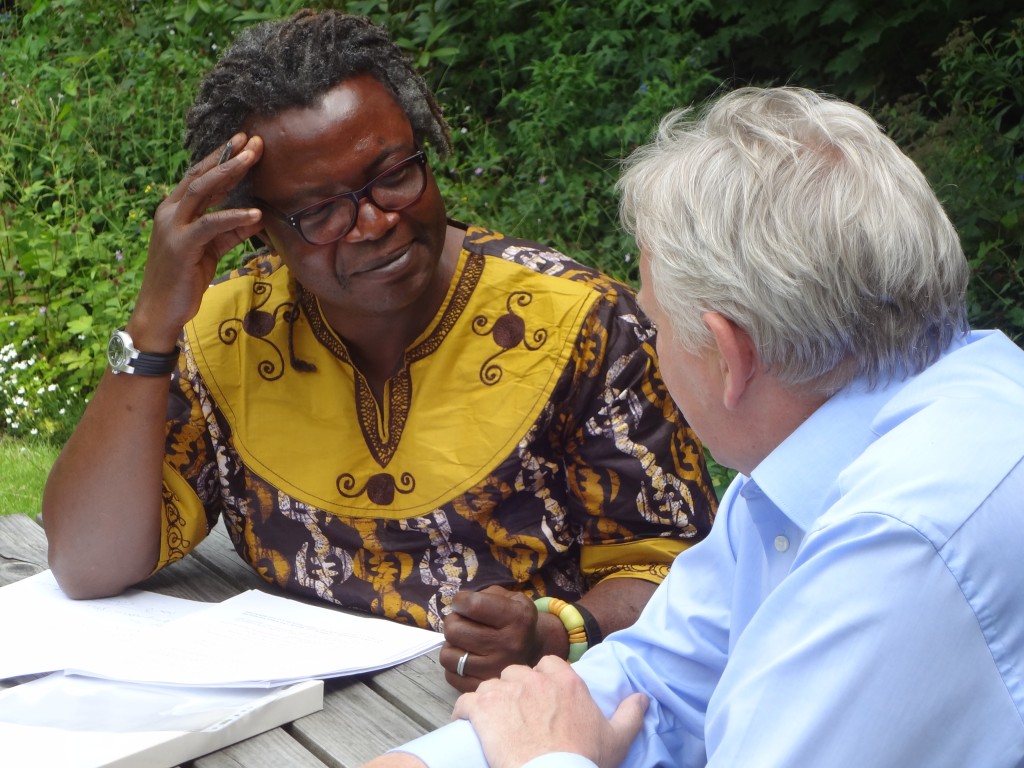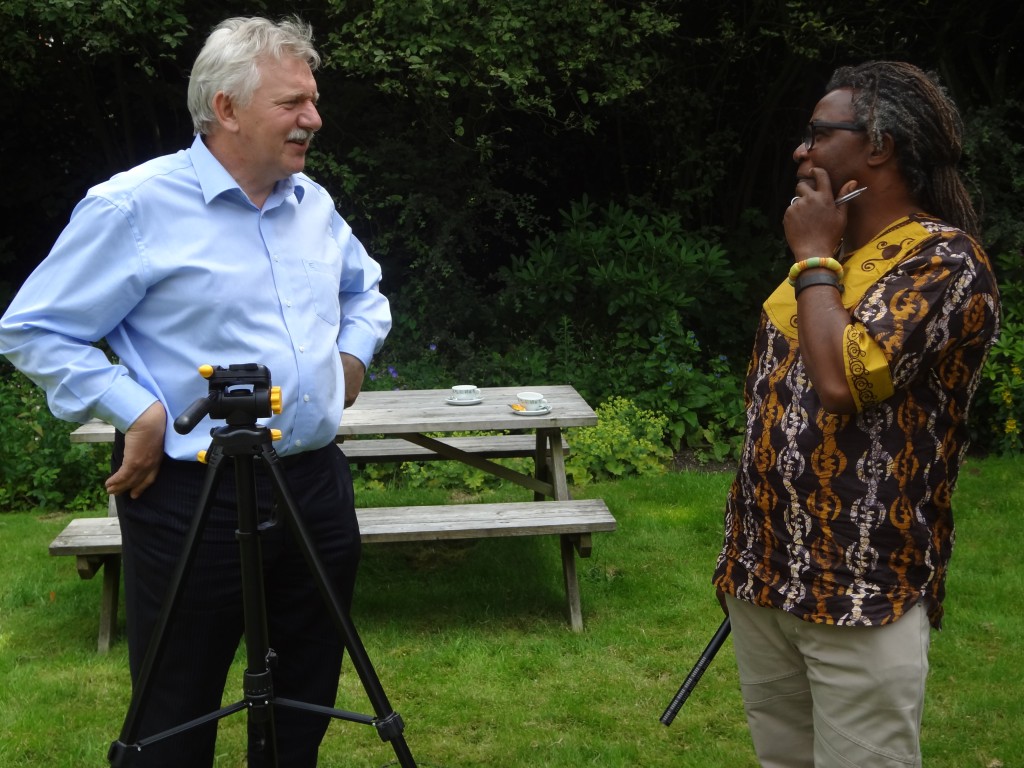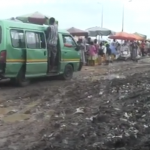Holland marked the 150th anniversary of the abolition of slavery
Posted by By Akogun Akomolafe at 8 October, at 17 : 09 PM Print

Warning: count(): Parameter must be an array or an object that implements Countable in /home/alaye/public_html/wp-content/themes/Video/single_blog.php on line 56
Published in the New African magazine, October 2013, pp34-35 – includes an interview with the Secretary-General of The Council of Churches in the Netherlands, Mr. Klaas v.d. Kamp
July 1st, 2013 marked the 150 years the Netherlands formally abolished slavery. Actually, it took another ten years before the slaves began to enjoy their freedom. Many descendants, therefore, consider 1873, and not 1863, as the date of abolition.
England proclaimed abolition in 1834; the French in 1848 and the USA in 1865. So, the Netherlands was one of the last countries to abolish the abhorrent crime. Students of history will remember that it was also the Dutch in Africa who were also the last to decolonize in South Africa.
The occasion was marked at the National Slavery Monument at the Oosterpark in the east of the Dutch commercial capital, Amsterdam.
King Alexander III and Queen Máxima were among the important people that graced the occasion.
The Netherlands, the small northern European country was among the most enthusiastic of slave nations. As the historian, Nordholt informed us: “The Dutch share in the slave-trade was large: in fact, in the seventeenth century, it was the largest. The Dutch West India Company had various settlements on the African coast, and millions of slaves were ferried from there, especially during the time of the Dutch occupation of Brazil. In the twelve years (1637-48) they transported no less than 23,163 slaves from Elmina and Loanda, for an amount of 6, 714, 423 guilders and 60 cents, (the Dutch were very precise!) They bought slaves from the Congo for 40 to 50 guilders and sold them in Brazil for 200 to 800 guilders. Certainly a worthwhile business.” (J.W. Schulte Nordholt, ‘The People that Walk in Darkness’. Ballantine Books, New York).
Below is how the Nordholt described the scene from a slave-trade:
“I stopped the carriage at the water-side, to behold a group of human beings, who had strongly attracted my attention… They were a drove of newly imported Negroes, men, and women, with a few children, who were just landed from on board a Guinea ship that lay at anchor in the roads, to be sold for slaves. The whole party was such a set of scarcely animated automatons, such a resurrection of skin and bones, as forcibly reminded me of the last trumpet. These objects appeared at that moment to be risen from the grave, or escaped from Surgeons’ Hall; and I confess I can give no better description of them, than by comparing them to walking skeletons covered with a piece of tanned leather.” (J.W. Schulte Nordholt, op. cit.).
The Dutch were not only leading participants in the Trans-Atlantic slavery, but they were also the cruelest among the slave-masters. As we read here: “The Dutch had established themselves in Berbice in 1624. During the years 1624 to 1763, they were the cruelest of slave masters. The Dutch slave code was much harsher than the Spanish code (the savagery of the Dutch code is shown by one provision of calculated cruelty: the burning alive of mutinous slaves over a slow fire). The Dutch had no institution comparable to the Spanish audiencia, a tribunal which included four judges. The ruthlessness of the Dutch created the situation that came to a climax in the Berbice slave rebellion.” (‘Marcus Garvey and the vision of Africa,’ edited by John Henrik Clarke. Vintage Books, New York. p.19).
Sadly, but not surprisingly, slavery remains a taboo subject in a country that profited so enormously from it.
Like most Europeans, the Dutch like only those aspects of history that celebrate themselves.
Many Dutch people went through school/life learning absolutely nothing about the vast crime that contributed so much to the wealth that they so much enjoy today.
And it seems that all that Dutch hagiographers busy themselves with today was to trumpet the concoctions of African chiefs gathering and selling their people to God-fearing, innocent traders from Europe.
Missing in the ‘blame the victim’ narratives of Dutch hagiography are accounts of the letter King Affonso I, a king of Congo, wrote to King John of Portugal in 1526 to condemn the enslavement of his people. Madam Tinubu, a slave-trader who became an ardent abolitionist after discovering the true nature of the horrendous trade, remain unmentioned in Dutch chronicles. Dutch commentators would like to pretend that they never heard of figures like Queen Njingha Mbandi of Ndongo (in modern Angola) who fought gallantly to drive the Portuguese out of her realm. They will also feign ignorance of the various battles King Agaja Trudo of Dahomey fought to keep the slavers away from his kingdom and stopped them from building their slave forts.
Mention is not made of the internecine wars Europeans instigated to fuel their despicable trade.
Of course, these pathetic Dutch distortionists, trying desperately to salve their conscience, will not tell us how these powerful African kings were subdued, when Europeans supplied better guns to their rivals in order to overwhelm them.
They wax lyrical only when they talk about those African kings they managed to co-opt into their nefarious trade.
Naturally, no mention is ever made of vast qualitative differences in the slavery Europeans introduced like, for example, the reduction of human beings to chattel properties and the deprivation of every vestige of humanity or the breeding of human beings like cattle.
Do we need to add more?
Missing in the narratives is the obvious contradiction of why people need guns, gunboats and instruments of violence and wars if they were genuinely interested in conducting honorable trade. Or why it is that only Europeans, among the branches of humanity, developed the mindset of ‘why pay for it when you can kill for it,’ – a mindset that remains totally undiminished even in civilized today?
Of course, Dutch children are spare the unpleasant tasks of learning such disturbing truth that Europeans enslaved themselves in their so-called New World before they turned to Africa.
“When someone removes the cataracts of whiteness from our eyes, and when we look with unclouded vision on the bloody shadows of the American past, we will recognize for the first time that the Afro-American, who was so often second in freedom, was also second in slavery.
“Indeed, it will be revealed that the Afro-American was third in slavery. For he inherited his chains, in a manner of speaking, from the pioneer bondsmen, who were red and white.
“The story of this succession, of how the red bondsmen and of how white men created a system of white servitude which lasted in America for more than two hundred years, the story of how this system was created and why, of how white men and white women and white children were brought and sold like cattle and transported across the seas in foul ‘slave’ ships, the story of how all this happened, of how the white planter reduced white people to temporary and lifetime servitude before stretching out his hands to Ethiopia, has never been told before in all its dimensions. As a matter of fact, the traditional embalmers of American experience seem to find servitude enormously embarrassing and prefer to dwell at length on black bondage in America. But this maneuver distorts both black bondage and the American experience. …In the first place, white bondage lasted for more than two centuries and involved a majority of the white immigrants to the American colonies. It has been estimated that at least two out of every three white colonists worked for a term of years in the fields or kitchens as semi-slaves. A second point of immense importance in this whole equation is the fact that white servitude was the historical foundation upon which the system of black slavery was conducted.
“In other words, white servitude was the historic proving ground for the mechanisms of control and subordination used in Afro-American slavery. The plantation pass, the fugitive slave law, the use of the overseer and the house servant and the Uncle Tom, the forced separation of parents and children on the auction block and the sexual exploitation of servant women, the whipping post, the slave chains, the branding iron; all these mechanism were tried out and perfected first on white men and white women. Masters also developed a theory of internal white racism and used the traditional Sambo and minstrel stereotypes to characterize white servants who were said to be good-natured and faithful but biologically inferior and subject to laziness, immorality, and crime. And all of this would seem to suggest that nothing substantial can be said about the mechanisms of black bondage in America except against the background and within the perspective of the system of white bondage in America.” – Lerone Bennet, quoted by John Henrik Clarke in the introduction to ‘World’s Great Men of Color‘, Collier Books.
Incredible as it may seem, the Christian church which today drips with brotherly love and all that, was at the forefront of the abhorrent trade in human flesh and received much of its inglorious wealth from this unholy trade.
In 1452, Pope Nicholas V issued a papal bull Dum Diversas, which granted Portuguese King Alfonso V the right to reduce any “Saracens, pagans and any other unbelievers” to hereditary slavery thus legitimizing the incipient trade in slaves. This bull was further extended in the papal bull Romanus Pontifex of 1455.
1493, Pope Alexander VI, through the papal bull, Inter Caetera, extended these rights to Spain to cover the New World (the Americas and parts of the Pacific).
Even relatively enlightened Christians like St. Thomas Aquinas opined that “although the subjection of one person to another (servitus) was not part of the primary intention of the natural law, it was appropriate and socially useful in a world impaired by original sin.”
Taking their cue from the Pontiffs, Christian theologians zealously published texts to justify the odious trades and few slave ships sailed without Christian priests on hand to bless them.
Many Christians today will feel discomfited by the fact that the first slave ship that actually took African slave to the USA was named “The Good Ship Jesus” lent to the Pirate John Hawkins by the British Monarch, Queen Elizabeth I.
Things appear to be changing though. Whilst Dutch politicians, like their counterparts in the Western world, fear the financial consequences of rendering a formal apology, the Netherlands Council of Churches in June of this year offered a public apology, for the role the church played in the Trans-Atlantic Slavery.
Femi Akomolafe went to interview the Secretary-General of the Council, Klaas van der Kamp, to find out more about the reasons for the apology.
Here are excerpts:
1 Can you kindly introduce yourself; who is Klaas van der Kamp?
Ans: Thank you. My name is Klaas van der Kamp. I am the Secretary-General of the Netherlands Council of Churches with headquarters in Amersfoort, in the Netherlands.
I am actually from the province of Friesland in the northern part of the Netherlands. My father was a Dairy farmer.
My recollections of life was milking the cow at an early age. It was an age where children helped their parents on their farms.
My father had one hundred cows. And as soon as I was old enough, he divided the milking equally between us; so I had to do milk fifty cows. It was a serious job as the cows cannot be left un-milked for long.
I hated the job but it must be done. I had developed a passionate love for reading, so what I did was tried to take the bad effects off by reading copious books. I devised some ways that allowed me to milk cows and read my books simultaneously.
One funny tradition we had which I still remember well was that all the cows were given names. They were named after important and famous people. We started naming them after members of the Royal family. When that was exhausted, we named them after members of our family. So, I had a cow named after me.
Looking back today, I realized that I learned quite a lot from my father. Although it was a tough life and hard job, it taught me discipline and responsibility. It also allows me to relate better with nature which helped tremendously in my theological profession.
As a farm hand, you have to know the land intimately, and you grew up developing special bonds with the animals.
2 Tell us something about your education?
Ans: I have always been interested in books. All that I ever want to do was to just read and read. That also helped a lot when I went to study. I studied Theology but was advised to wait before I could get a posting. So, I studied Mass Communication and later Economics.
3 Klaas, what can you tell us about your professional life?
Ans: I worked with some regional newspapers in Friesland. I wrote mostly on matters that relate to religion. The profession of journalism also allows me to relate well to people. I remember an assignment I was given to interview about one hundred women. I came back with a story which I thought was great. My editor looked at it and shook his head. He rejected it on the ground that I did not show enough interest in the women, and this was reflected in the piece I wrote.
He taught me that in order to write about or discuss people, you must show sufficient interest in them. He taught me that I will continue to produce superficial stuff unless I develop some interests in the people I interview.
That was also a very important lesson I learned that was also very useful for my theological work.
People are very important.
4 And from journalism, you moved to theological work. What is the story?
Ans: After a stint in journalism, I got called up to work as a minister. I later served as Bishop in a parish. But I was still involved in writing and became the publisher of the Jongbloed Publishing House which is based in Heerenveen, in Friesland.
We have a big printing press and we print large quantities of materials, mostly Bibles, Biblical materials and Hymn books.
We produce quite a lot of materials with most of it going to foreign countries.
5 For a small country, the Netherlands has so many factions within the church, can you tell us a brief story of what led to the factionalization?
Ans: There is a saying that wherever you have two Dutch people, you have two different opinions on every subject. We Dutch do not like to be lorded over, we naturally carry this over to our religion. We love to have our own opinions and are always prepared to defend them.
Remember that we Frisians (people from Friesland) even have strong independent thoughts that are different from the rest of the Dutch people.
We won a solitary victory over the Netherlands in a war in 1345, but we still celebrate it today. We even have our own national anthem which we sing boisterously whenever our football club, Heerenveen, plays.
It is something Dutch that when people disagree over issues of doctrines, they think that it best to part ways and form their own church.
6 Was your organization, Raad van Kerken (Council of Churches) set up to address this issue, and can you kindly tell us what the types of activities your organization deals with?
Yes. The larger churches came together when they saw the wisdom in unity. Today eighteen churches are members of the Council. Altogether we represent seven of the eight million professing Christians in the Netherlands.
We are quite sizable.
The council acts as an umbrella organisation. Each member has equal voice and vote. We meet and deliberate on various issues and come to agreements.
7 As Secretary-General, what are your functions?
I am the chief scribe. I coordinate the organization of the secretariat and is responsible for the day to day running of the office. I am also the public face of the council; I represent the organization at public functions both in the Netherlands and outside the country.
8 This year marks the 150 years of the end of slavery. The Netherlands was, at one time, the biggest slave trading country in the world. Do you think the country has done enough to assuage the great sufferings of its slavery past?
Ans: It is a difficult thing to say. How can you ever assuage for horrendous suffering of that scale?
9 Many people in Europe appear not to grasp the enormity of the crimes committed during slavery, do you think that it is important that it should form part of history books and school lessons?
Ans: Sure, sure. Almost every Dutch person is familiar with the Nazi occupation in 1943, but not many people are aware of the slavery era.
What we tell people is that while we remember our pains at the hands of the Nazis because we were victims, it is equally important to remember those who were also victims of the crimes we committed.
There were so many victims of the Black Holocaust of which we were among the principal perpetrators. It is important that we continue to teach and to learn about that aspect of our history, however unpleasant.
Gradually people came around that it was time to rethink our role in the dastardly crime, and offer apologies.
10 In June 2013, you said that the Council will offer an apology for the role Church played in offering theological and spiritual justification for slavery. Can you tell us what reasons informed this decision?
We took a long and hard look at the issue of slavery, deliberated on it extensively and came to the conclusion that an apology is long overdue.
It was not an easy decision as it involves so many emotions. But we believe that it was the correct and the right thing to do. And we believe that this year 150 anniversary of the abolition offered us a good opportunity to render the apology.
11 What do the Dutch people think of your apology?
The reactions we got from the member of our churches were overwhelmingly positive. About eighty percent of them were in total agreement with our decision. And from the larger Dutch society, it was an equally tremendously positive reaction. For many Dutch people, it was like we lifted a great burden off their chest. People must have thought seriously about it. Many wrote to thank us for the courage to offer the long overdue apologies. The remaining twenty percent that was against grounded their objections on emotions.
12 Many theological texts were published to justify and support slavery, do you think that the time has come for the church to formally denounce them and make a bonfire of them?
Ans: Yes, very sadly many theologians wrote to justify the crime. For reasons that are difficult for us to understand today, they used the Bible to justify the crime. This is, of course, appalling.
It is hard today to imagine what thinking went into those type of actions.
It is difficult for us today to think of the evil that went into people thinking about how to make money, even if it causes so much pains to their fellow human beings.
It was an epoch which I can assure you many Dutch Christians are not particularly proud of today.
13 What do you think that the peoples of the world can begin to do in order to eradicate the vestiges of slavery and create a new world of genuine love, solidarity, and brotherhood?
Ans: We need to right the wrong of the past of course. Apologize sincerely for the crimes committed, and ask for forgiveness from those that were wronged.
The apology has to be genuine and it must be reflected in the ways the descendants of both the victims and the perpetrators treat one another. Society needs to acknowledge the pains caused in the past and ensure that such atrocities are never, never again committed. From there, hopefully, we can begin to build a new relationship where every human being is valued for his humanity and not because of the color of his skin.
We shall then have a new world where the urge to make profits does not become the overarching impetus.
14 Have you ever been to Africa and does your council have connections with African churches?
No, I have not been to Africa, but would dearly love to go. I would especially like to visit the Elmina Castle in Ghana because it carried so much history. A visit to Elmina would definitely enrich my own theological education/experience.
But we have very good contacts with African churches. Most of the materials we publish go to Africa. We have just concluded a deal with a South African church on producing and supplying them with 70,000 bibles in Zulu.
15 Christianity appears to have come full circle; today it is declining in Europe, while in Africa, it is in full bloom. What do you think of this development?
Ans: I feel thrilled and positively encouraged by it. We learned a lot from our counterparts from Africa as they bring entirely new perspectives to Christendom.
For example, Africans provide the majority of new thinking and the new ideas at the World Council of Churches.
Today, African ministers provide new insights into Christian doctrines. We are learning a lot of things on spirituality from the African ministers. Many of them are things that those of us in Europe seem to have forgotten.
From African ministers, we learned, for example, how to relate better with nature, and not to look at nature as something to be conquered and mastered, but as something to cherish and nurture. Plato taught us about separating body and soul, we learned from the Africans that this dichotomy was wholly unnecessary. From our African counterparts, we learn to look at the world with wonderment and enjoy the mysteries therein.
About the Author
Femi Akomolafe is a passionate Pan-Africanist. A columnist for the Accra-based Daily Dispatch newspaper and ModernGhana, and Correspondent for the New African magazine, Femi lives in both Europe and Africa and writes regularly on Africa-related issues for various newspapers and magazines.
Femi was the producer of the FOCUS ON AFRICANS TV Interview programme for the MultiTV Station.
He is also the Man and Machine Coordinator at Alaye Dot Biz Limited, a Kasoa-based Multimedia organization that specializes in Audio and Video Production. He loves to shoot and edit video documentaries.
His highly-acclaimed books (“Africa: Destroyed by the gods,” “Africa: It shall be well,” “18 African Fables & Moonlight Stories” and “Ghana: Basic Facts + More”) are available for sales at the following bookshops/offices:
- Freedom Bookshop, near Apollo Theatre, Accra.
- WEB Dubois Pan-African Centre, Accra
- Ghana Writers Association office, PAWA House, Roman Ridge, Accra.
- Afia Beach Hotel, Accra
Where to buy them online:
On Lulu Books:
18 African Fables & Moonlight Stories https://goo.gl/Skohtn
Ghana: Basic Facts + More: https://goo.gl/73ni99
Africa: Destroyed by the gods: https://goo.gl/HHmFfr
Africa: It shall be well: https://goo.gl/KIMcIm
Africa: it shall be well
on Kindle books: https://www.createspace.com/4820404
on Amazon books: http://goo.gl/QeFxbl
on Lulu Books: https://goo.gl/SQeoKD
Africa: Destroyed by the gods
on Kindle books: https://www.createspace.com/4811974
18 African Fables & Short Stories: https://goo.gl/s9tWAf
on Amazon books: http://goo.gl/1z97ND
on Lulu Books: http://goo.gl/KIMcIm
My Lulu Books page: http://www.lulu.com/spotlight/FemiAkomolafe
Get free promotional materials here:
- Africa: it shall be well: http://alaye.biz/africa-it-shall-be-well-introduction-in-pdf/
A FREE Chapter of ‘Africa: It shall be well’ can be downloaded here: http://alaye.biz/africa-it-shall-be-well-a-free-chapter/
- Africa: Destroyed by the gods (How religiosity destroyed Africa) http://alaye.biz/africa-destroyed-by-the-gods-introduction/
A FREE Chapter of ‘Africa: Destroyed by the gods’ can be downloaded here: http://alaye.biz/africa-destroyed-by-the-gods-free-chapter/
Femi’s Blog: www.alaye.biz/category/blog
Websites: www.alaye.biz ; www.akogun.tv
Femi on Amazon https://www.amazon.com/author/femiakomolafe
Femi Akomolafe’s Lulu Books page: http://www.lulu.com/spotlight/FemiAkomolafe
Twitter: www.twitter.com/ekitiparapo
Facebook: https://www.facebook.com/FemiAlaye
Gmail+: https://plus.google.com/112798710915807967908;
LinkedIn: www.linkedin.com/in/femiakomolafe;
YouTube Channel: https://www.youtube.com/user/fakomolafe
Email: fakomolafe@gmail.com
Profile on New African magazine: http://newafricanmagazine.com/tag/femi-akomolafe/
Alayedotbiz, Blog, Interviews, News, Polemics, Uncategorized








